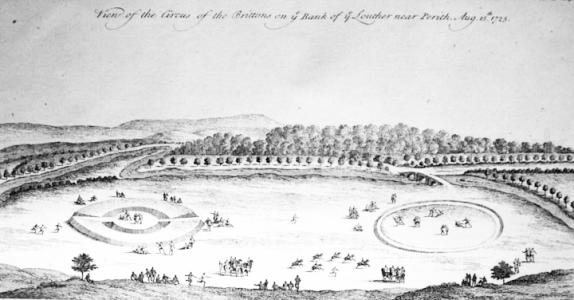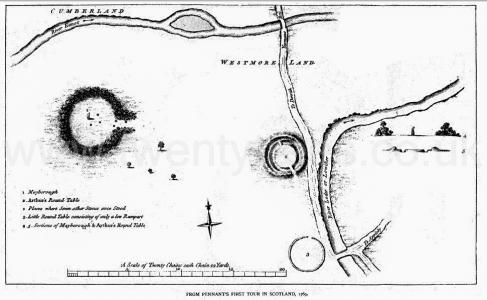Europe, British Isles, North-West England, Cumberland, Eamont Bridge, Mayburgh Henge [Map]
Mayburgh Henge is in Eamont Bridge, Cumberland.
Avebury by William Stukeley. Though upon first sight of the place I knew its purport, yet I was more fully convinced thereof when I went to see Mayborough [Map], as called, which is a little higher up the hill, on an eminence higher than any near it, and full west from this place, or circus: it is a vast concavity, of the same diameter as the circles just mentioned, -viz. 300 foot: it is made with an artificial vallum of loose stones, without any ditch, carried with great labour from some other place, and here orderly piled up, so as to make a rampart as high and as broad as that at Abury: in some places the turf, with which it was covered originally, is peeled off: it hopes inward with a gentle descent on account of spectators; outwardly it is as steep as the nature of the materials would suffer, and now covered over with great timber-trees; the entrance is wide, and opens full east, and to the circus. Within this fine plain, which is now ploughed up, have been two circles of huge stones; four remaining of the inner circle till a year or two ago, that they were blown to pieces with gunpowder: they were of a hard black kind of stone, like that of the altar at Stonehenge: one now stands, ten foot high, seventeen in circumference, of a good shapely kind; another lies along; this inner circle was fifty foot in diameter. One stone, at least, of the outer circle remains, by the, edge of the corn; and some more lie at the entrance within side, others without, and fragments all about. Just by the entrance, along the road runs a spring, full east ward.
This I suppose to be a great British temple, where the country met on solemn days to sacrifice. After the religious duties were over, they went down to the circus to celebrate their games: and I could not but admire the fine genius of these people in chusing places for their sports; for upon the verge of the acclivity, along the circus, an infinite number of people might stand to see the whole without the least inconvenience, besides those in the plain between the two circles; and these two circles admirably well executed the intent of the meta's, but much better than those in the Roman circus's. In ploughing at Mayborough they dug up a brass Celt. On the other side of the Eimot, upon a high ground over-looking all, is a very fine round tumulus, of a large size, and set about with a circle of stones: this in all probability was the funeral monument of the king that founded the temple and circus. Somebody has lately been digging away part of the barrow, and carried off some of the stones, and demolished others.
1725. William Stukeley (age 37) sketched King Arthur's Round Table, Mayburgh Henge [Map] and Little Round Table.

1769. Pennant sketch of Mayburgh Henge [Map] and King Arthur's Round Table.

Transactions of the Cumberland and Westmorland Antiquarian and Archaeological Society Volume 40 Pages 169 to 206. IN 1938 Professor R. G. Collingwood produced, in these Transactions (xxxviii, 1-31), an Interim Report on the excavations of 1937 at King Arthur's Round Table. Illness prevented him from completing the task, and the final investigation was conducted by the writer, to whom it had been entrusted, between 10th July and 27th August, 1939. Eight workmen were employed throughout, while the experienced Mr. W. Cruddas of Greenhead acted again as foreman. Mrs. Spence undertook the task of Excavations Secretary and Guide, and superintended the filling-in during the anxious days preceeding the outbreak of war. Dr. J. E. Spence devoted the first week of his vacation to joint direction, while Miss M. Cross and Miss K. S. Hodgson gave voluntary help in the more delicate tasks. It was particularly useful to have Mrs. Collingwood's presence for a week during the excavation. Mr. Hay and Dr. Goodchild gave much valuable advice on geological problems. Mr. R. Morton Rigg, as during the first season, undertook the organisation of labour and tools most generously lent by the Penrith Urban District Council. Captain Anthony Lowther, on behalf of Lowther Estates Limited, kindly extended permission to excavate, with the consent of the tenant, Mr. W. Bainbridge of the Home Farm; while H.M. Office of Works authorised excavation of a scheduled monument, a visit being paid by Inspector P. K. Baillie-Reynolds. To all these helpers and to Major Porter, I offer heartiest thanks for their assistance. Among many visitors I had the pleasure of welcoming Messrs. Grahame Clark and J. F. Grimes. Finally three trenches were made through the so-called Little Round Table (see Appendix) and, in co-operation with H.M. Office of Works, the surviving standing-stone in the adjacent circle at Mayburgh [Map] was secured against collapse.